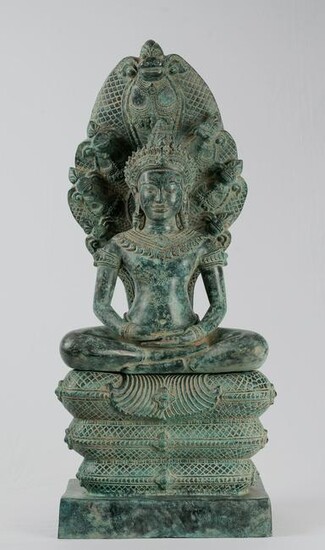Large Antique Bayon Style Khmer Bronze Meditating Naga
The iconic perfection of this figure of the Buddha seated in meditation on the coils of the Naga is typical of the refinement of bronze casting seen during the 13th century post-Angkor period. The almond shaped eyes, broad cheekbones and forehead, as well as the elaborate jewellery, the naturalism of the body and limbs and the benign expression of the face, are, characteristic of the Bayon style.
The representation of the Buddha, its iconography alluding to the protection offered by the naga Muchalinda - whose expressive heads enhance the vitality of the sculpture - when the sage was meditating during a rainstorm, is one of the most frequently created during the 12th century in Cambodia. The image become the major icon worshipped during the early reign of Jayavarman VII, and was finally recognised as the Khmer's supreme transcendent Buddha.
Buddha is seated on a three-tired throne, with the flaring head of a giant Naga, the serpent King Muchalinda, rising behind protectively behind. His hands are in the Dhyana mudra, the gesture of Meditation.
The Buddha's face is serene, with a naturalistic and warm expression; his head is topped by a detailed ushnisha, in the Bayon style. The serpent is well rendered and symmetrical. The throne is formed by the coils of the serpent. The story told here being that Muchalinda protected the Buddha from heavy rain.
The statue is cast in the round, rather than as a relief on a stela. From this, we can infer that Khmer sculptors would have desired their artwork to be viewed from all sides and thus placed in the center of temples rather than against a wall. While this artwork was religious - priests supervised its execution - its realism is unmistakable.
The Buddhas hands are in Dhyana Mudra, the hand gesture that promotes the energy of meditation, deep contemplation and unity with higher energy.
The sculpture is cast of three separate, interlocking parts. The Buddha is seperately cast and slots into the Naga's integrally cast body. Likewise with the hood of the Naga.
Medium: Bronze
Dimensions: 81cm/32”
General Condition: Good condition. Consistent with age.
SCBR2721
View it on
Estimate
Time, Location
Auction House
The iconic perfection of this figure of the Buddha seated in meditation on the coils of the Naga is typical of the refinement of bronze casting seen during the 13th century post-Angkor period. The almond shaped eyes, broad cheekbones and forehead, as well as the elaborate jewellery, the naturalism of the body and limbs and the benign expression of the face, are, characteristic of the Bayon style.
The representation of the Buddha, its iconography alluding to the protection offered by the naga Muchalinda - whose expressive heads enhance the vitality of the sculpture - when the sage was meditating during a rainstorm, is one of the most frequently created during the 12th century in Cambodia. The image become the major icon worshipped during the early reign of Jayavarman VII, and was finally recognised as the Khmer's supreme transcendent Buddha.
Buddha is seated on a three-tired throne, with the flaring head of a giant Naga, the serpent King Muchalinda, rising behind protectively behind. His hands are in the Dhyana mudra, the gesture of Meditation.
The Buddha's face is serene, with a naturalistic and warm expression; his head is topped by a detailed ushnisha, in the Bayon style. The serpent is well rendered and symmetrical. The throne is formed by the coils of the serpent. The story told here being that Muchalinda protected the Buddha from heavy rain.
The statue is cast in the round, rather than as a relief on a stela. From this, we can infer that Khmer sculptors would have desired their artwork to be viewed from all sides and thus placed in the center of temples rather than against a wall. While this artwork was religious - priests supervised its execution - its realism is unmistakable.
The Buddhas hands are in Dhyana Mudra, the hand gesture that promotes the energy of meditation, deep contemplation and unity with higher energy.
The sculpture is cast of three separate, interlocking parts. The Buddha is seperately cast and slots into the Naga's integrally cast body. Likewise with the hood of the Naga.
Medium: Bronze
Dimensions: 81cm/32”
General Condition: Good condition. Consistent with age.
SCBR2721



